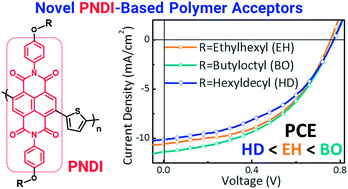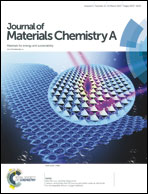Synthesis and side-chain engineering of phenylnaphthalenediimide (PNDI)-based n-type polymers for efficient all-polymer solar cells†
Abstract
We designed and synthesized a series of n-type conjugated polymers by introducing phenylnaphthalenediimide (PNDI) as a novel n-type building block, and investigated the effect of side-chain engineering of the polymer acceptors on the performance of all-polymer solar cells (all-PSCs). The optical, electrochemical, and structural properties of the polymers with three different side chains of 2-ethylhexyl (PPNDI-EH), 2-butyloctyl (PPNDI-BO), and 2-hexyldecyl (PPNDI-HD) groups were examined. Interestingly, the PNDI-based polymer having the longest side chain showed a higher degree of edge-on oriented intermolecular assembly in thin films, thereby resulting in the highest field-effect electron mobility among the three polymers. Also, we examined the performance of PNDI-based polymers as polymer acceptors in all-PSCs. Unlike the trend in the field-effect transistor, the PPNDI-BO-based all-PSCs exhibited the highest power conversion efficiency (PCE) of 4.25% among the three polymer blends. This was attributed to the well-balanced hole/electron transport and higher exciton dissociation probability in the PPNDI-BO-based all-PSCs, benefitted from the well-intermixed blend morphology between the polymer donor and PPNDI-BO.



 Please wait while we load your content...
Please wait while we load your content...